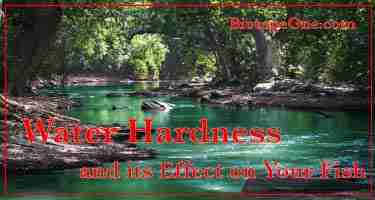Wild fish can adapt. I can show you a lovely paper on acclimating zebra danios to soft water. The acclimation process took two weeks. True acclimation cannot be done in an hour a day or even a week.
Gill membrane remodeling with soft-water acclimation in zebrafish (Danio rerio)
I happen to know one of the people doing rewrites on Seriously fish for years. We have had a number of discussion on fish related topics. Noodle knows him as well. I know that one of his favorite sources, with whom he speaks regularly, is Dr. Neil Monks, Google him.
I have relied for more years than sprinkle has been alive for the information on the SF site. I will continue to do so, and will also contimue to recommend the site to those who want good information. One of the best features of their fish profiles, and one which most such sites rarely offer, is a reference list for the information in the article. Now you actually have to read through the article before you get to the references, or you could scroll down.
I just grabbed this from the site from their page for
Paracheirodon innesi (MYERS, 1936) Neon Tetra
https://www.seriouslyfish.com/species/paracheirodon-innesi/
There are 7 references listed at the end of the piece. lets have a look at just one of these and who the authors are:
Oliveira, C. A., G. S. Avellino, K. T. Abe, T. C. Mariguela, R. C. Benine, G. Orti, R. P. Vari, and R. M. Corrêa e Castro, 2011 - BMC Evolutionary Biology 11(1): 275-300
Phylogenetic relationships within the speciose family Characidae (Teleostei: Ostariophysi: Characiformes) based on multilocus analysis and extensive ingroup sampling.
https://link.springer.com/article/10.1186/1471-2148-11-275
Claudio Oliveira
- Dept. Morfologia, Instituto de Biociências, Universidade Estadual Paulista, Botucatu, São Paulo, Brazil
Gleisy S Avelino- Dept. Morfologia, Instituto de Biociências, Universidade Estadual Paulista, Botucatu, São Paulo, Brazil
Kelly T Abe- Dept. Morfologia, Instituto de Biociências, Universidade Estadual Paulista, Botucatu, São Paulo, Brazil
Tatiane C Mariguela- Dept. Morfologia, Instituto de Biociências, Universidade Estadual Paulista, Botucatu, São Paulo, Brazil
Ricardo C Benine- Dept. Morfologia, Instituto de Biociências, Universidade Estadual Paulista, Botucatu, São Paulo, Brazil
Guillermo Ortí- Dept. Biological Sciences, The George Washington University, USA
Richard P Vari- Dept. Vertebrate Zoology, Smithsonian Institution, National Museum of Natural History, USA
Ricardo M Corrêa e Castro- Laboratório de Ictiologia de Ribeirão Preto (LIRP), Dept. Biologia, FFCLRP, Universidade de São Paulo, Ribeirão Preto, São Paulo, Brazil
Why would anybody think that the 6/8 researchers who are actually in Brazil would know anything about Neon Tetras. I mean where do these fish actually live? ROTFLMAO.
Most readers will likely not recognize any of the names above, so lets look at the reference list for:
Paracheirodon axelrodi (SCHULTZ, 1956) Cardinal Tetra
https://www.seriouslyfish.com/species/paracheirodon-axelrodi/
Do some research and Google just the two names I have colored yellow.
- Bleher, Heiko, 2008 - Tropical Fish Hobbyist, October 2008: 92-95
A Story of Four Neon Tetras, Part Two: And Now a Fourth Neon!
- Cooke, G. M., N. L. Chao and L. B. Beheregaray, 2009 - Freshwater Biology 54: 1216–1232
Phylogeography of a flooded forest specialist fish from central Amazonia based on intron DNA: the cardinal tetra Paracheirodon axelrodi.
- Géry, J., 1977 - T.F.H. Publications, Inc.: 1-672
Characoids of the World.
- Ikeda, T. and S. Kohshima, 2009 - Environmental Biology of Fishes 86: 427-441
Why is the neon tetra so bright? Coloration for mirror-image projection to confuse predators? “Mirror-image decoy” hypothesis.
- Mikolji, I., 2009 - Tropical Fish Hobbyist 635: 70-75
Cardinal tetras in their natural nabitat.
- Oliveira, C. A., G. S. Avellino, K. T. Abe, T. C. Mariguela, R. C. Benine, G. Orti, R. P. Vari, and R. M. Corrêa e Castro, 2011 - BMC Evolutionary Biology 11(1): 275-300
Phylogenetic relationships within the speciose family Characidae (Teleostei: Ostariophysi: Characiformes) based on multilocus analysis and extensive ingroup sampling.
- Reis, R. E., S. O. Kullander and C. J. Ferraris, Jr. (eds), 2003 - EDIPUCRS, Porto Alegre: i-xi + 1-729
Check list of the freshwater fishes of South and Central America. CLOFFSCA.
- Weitzman, S. H. and W. L. Fink, 1983 - Bulletin of the Museum of Comparative Zoology 150(6): 339-395
Relationships of the neon tetras, a group of South American fishes (Teleostei, Characidae), with comments on the phylogeny of New World characiforms.
Here are a couple of hints:
Heiko Bleher (born October 18, 1944) is a German
researcher,
author,
photographer and
filmmaker best known in the
scientific community for his contribution to the exploration of fresh and brackish water habitats worldwide and the discovery of many species of fish and
aquatic plants, several of which carry his name, discovery location or are named in honor of Bleher's family including
Hemigrammus bleheri,
[1] Leporinus bleheri,
[2] Bleheratherina pierucciae,
[3] Streatocranus bleheri,
[4] Channa bleheri,
[5] Phenacogrammus bleheri,
[6] Moenkhausia heikoi,
[7] Chilatherina bleheri,
[8] Vrisea bleheri,
[9] Hyphessobrycon amandae, named for his mother, and various others.
from
https://en.wikipedia.org/wiki/Heiko_Bleher
Weitzman has over 100 publicattions on fish related topics and Corydora weitzmani might ring a bell, too.
https://www.researchgate.net/profile/Stanley_Weitzman
For those with the patience to have read through this post, here is a reward, it is another excellent site I have regularly used for species information:
https://fish.mongabay.com/



